Lo-Fi Cartridge Construction and Function of the Constraint
My audio work has involved both the modification of the turntable apparatus and the destructive alteration of the vinyl media. Most recently, this has involved the construction of rather primitive home-built cartridges (and styli) in order to play standard vinyl records along with a variety of other objects. The aim is to achieve an almost “automatic” mode of music performance that involves minimal human intervention, in such a way that the composer / performer is constantly surprised.
The Constraint
Before heading into the “nuts and bolts” details of this practice I’d like to discuss the rationale for this activity. That is, why would one engage in such imprecise and poorly controllable methodologies in the composition, performance and production of audio work? The way that I approach turntable performance could be called experimental, in the sense of John Cage’s idea of experimental action: “simply an action the outcome of which is not foreseen” (Cage 1968, 69). Michael Nyman, in Experimental Music: Cage and Beyond (Nyman 1999), develops his well-known definition of “experimental music” in reference to similar statements made by Cage in the 1950s. In order to arrive at the unforeseen, Cage believed that the composer must arrive at a method that “bypasses taste and memory.” The traditional conception of the activity of composing could be said to involve a kind of sonic imagining — where a musical idea is expressed, or projected, from an inner source. For Cage this entails the creation of sounds, structures and melodies, that have, in a sense, been foreseen or fore-heard (in the composers mind), and are consequently based upon the memory of what the composer has heard before. In adopting strategies involving systems of chance and contingency, the experimental methodology aims at overcoming the subjectivised notions of genius and self-expression that had dominated modernist art and music.

I’m interested in an approach that, rather than utilising the masterful control of a precise instrument in order to transmit the inner emotions and ideas of the composer, utilises imprecision in order to create an obstacle to such a process of transparency. In other words, I’m against expression. But this does not mean that I wish to remove all feeling from the sound I produce. I’m not against feelings but as Cage says, “What I am against is the impositions of feelings” (Cage and Charles 1981, 148). The idea of handing over the compositional decisions to the machine (modified turntable, altered records, found objects) is to introduce what the French literary group Oulipo (Ouvroir de Littérature Potentielle) have called the “constraint”. By instituting a mechanical process that is somewhat beyond the artist’s control, a disconnection occurs that liberates the compositional or improvisational process from subjective and arbitrary decision-making. The function of the constraint is, as Fluxus artist Dick Higgins says, “to place the material at one remove from the composer” (Higgins 1978, 30). The whole purpose of the modification of the turntable instrument and the manipulation of its media (vinyl and other found objects) is to open up new possibilities where the sound is found rather than imagined. The non-intentional operation, or what another Fluxus artist George Brecht calls “the irrelevant process” (Brecht 2004), by limiting the arbitrary, opens up a space for a different kind of free play to happen.
Sanity Clause
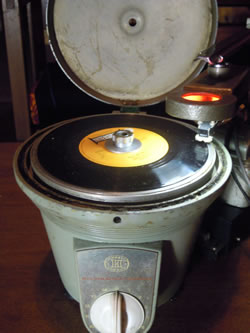
For many years I had been using the turntable as a means to produce unique sounds in conjunction with a variety of other sources (tape, instruments, electronics, etc.). But in 1990, I began a project with Garry Bradbury (of Size, and Severed Heads) where the agreed imposed limitation was that all sounds must originate from turntables. In this way, the nature of the constraint is pushed to the foreground in performances. The project was called Sanity Clause, after the famous Chico Marx line in A Night at the Opera (1935) “You can’t fool me, there ain’t no sanity clause.” Of course we were well aware of certain precedents in this field, for example the work of Christian Marclay and Boyd Rice, and in a rather different vein, John Cage’s Cartridge Music (1960). In 1990, however, we were introduced to the work of Milan Knižák, through the exhibition “Broken Music” curated by Ursula Block for the Eighth Biennale of Sydney (at the Ivan Dougherty gallery). The exhibition also featured John Cage’s work 33-1/3 (1969) involving 12 record players and 100 records, and a replica of Nam June Paik’s Random Access (1963–82). This was possibly the catalyst for our renewed attraction to vinyl.
For our Sanity Clause performances I constructed a number of cut-up disks where segments of different records were glued onto another record. Resembling pizzas, each sector of the disk overlapped the other so that the record could play without the needle becoming stuck (Fig. 1). The idea was to produce a kind of auto-montage. In the late 1990s I began collecting flexi-disks which made the assemblage of these “pizza disks” much easier. Since these disks are harder to come by than ordinary records, the operation functions as a kind of limiting constraint — in terms of the selection of audio material. The Sanity Clause performances utilised a number of turntables, some of which were modified in various ways. One turntable was constructed from an old medical centrifuge that revolved at some ridiculous speed around 3000 rpm (Fig. 2).
Cartridge Construction
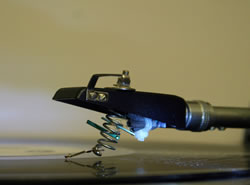
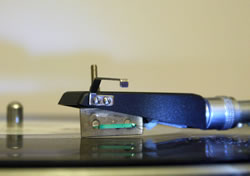
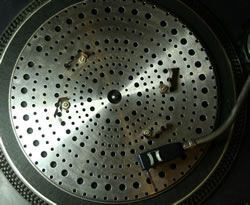
Some years ago I purchased a pallet load of various electronic items from an auction held by the Australian Broadcasting Corporation. Among these items was a box of turntable tone-arm headshells with the standard 4-pin connection used by most professional DJ and transcription turntables. In 2006 I began constructing hand-made cartridges from discarded headphone speakers. This involved mounting the small speaker on the headshell and attaching a wire, a spring or other sharp object to the membrane of the speaker and wiring the speaker connection to the headshell leads (in mono) [Figs. 3–4]. The vibration picked up by the improvised stylus is in this way transduced — in reverse — from the speaker membrane to the electronic systems. Attempts at getting higher fidelity resulted in much more fragile cartridges. Conversely, the more robust the cartridges were made, the less sensitive they became. After constructing the cartridges, I gathered together various objects to place on the turntables and play: plates, saucepan lids, metal film canisters, ceramic plates and sandpaper disks. The most productive of all was a stainless steel disk with multiple perforations of different sizes to which I attached spring steel clips that would function as obstacles in the path of the stylus (Fig. 5).
The objects were played with the cartridges on three turntables at a performance called “Turntablism” (Now Now festival) in late 2007, organised by the late John Blades. A Sedco GE12 graphic equalizer and an Orban 372A parametric equalizer were used to isolate the most interesting sounds from the apparatus in conjunction with a compressor / limiter to control the peaks. This first series of cartridges, however, suffered from two problems. First, in live performances audio feedback was always a problem. Second, they were not sensitive enough to render vinyl grooves audible.
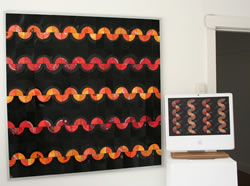
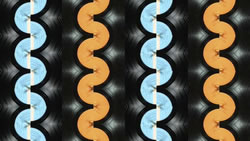

In 2009, I met Manne Schulze, a visual artist who works entirely with discarded vinyl records. He invited me to exhibit with him in a forthcoming exhibition in 2010. The pieces that I made for that exhibition were all responses to his work, and one of them involved a video that replicated his constructions in digital form and animated them. For the video soundtrack I wished to use the home-built cartridges, but I really wanted to use vinyl instead of objects, since the theme was the materiality of vinyl itself. During the previous year I attended a workshop at the Wired Lab in rural New South Wales, near Cootamundra, where I learned from Dave (Noyze) Burraston that they were using very tiny piezo elements to record the vibrations of long sections of fencing wire constructed by Alan Lamb. These were just what I had been looking for. They are small enough and light enough to glue to the stylus material (sharpened springs, pieces of spring steel). This produced much more sensitive cartridges that were able to play back vinyl as well as other objects. Moreover, whereas the original cartridges had been restricted to monophonic operation, the new piezo cartridges could now be wired up in stereo. Like the earlier mono constructions, each cartridge has its own unique sound, which is a product of the stylus material.
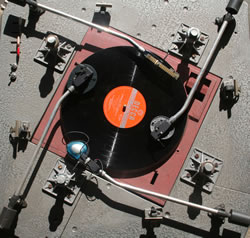
The resulting work is a 26-minute HD video entitled Schulzemix (2010). In making the video, I shot four quadrants of a number of records revolving on a turntable. Each quadrant is combined in different patterns that take there cue from the designs of Schulze’s assemblages. The records chosen fall into four categories. First, the kind of discarded vinyl with brightly coloured labels that Schulze uses in his work. Second, records that belong to the tradition of experimental turntable-as-instrument activity, such as Christian Marclay, Boyd Rice and Gum. Third, records with visually sticking label design, such as Kompakt twelve inches, and Joy Division’s Unknown Pleasures. And finally, a number of old 78s, which have their own unique artwork style. The exhibition of this work at Wilson Street Gallery in Sydney included a turntable performance which utilised a four-tone-arm turntable, constructed in the mid-1990s by close friend and collaborator John Jacobs, and used a combination of headphone and piezo cartridges (Fig. 7, Video 2).
Non-linear Random Structures
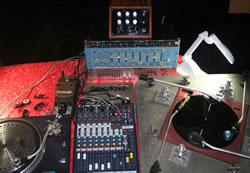
In all of these performances sounds are produced and arranged in a very much “automatic” manner. There is very little expressive or virtuosic intervention on the part of the performers. Rather, the machines are let to perform the work with very minimal assistance. When it comes to recording and producing finished material, I try to use effects and editing very sparingly, in order to let the sound of the machinic composition come through. Alternatively, I use a modular approach where a number of individual samples are looped and arranged to play (by means of aleatory scripting techniques in Adobe Flash Actionscript) in an infinitely changing mix. Since the sounds produced by the apparatus are often cyclic, the duration of each sample would correspond to the length of the cycle at either 33 or 45 rpm. In some cases, where there is significant variety between two or more consecutive cycles, the duration of the samples are extended to 2 or 4 cycles. In auto-Change (2009), each piece is made up of 13 segments that are played consecutively in random order. Each segment contains one sample which is looped a number of times (typically 16). The segments, each of which have an individual attack and decay envelope, overlap each other and are thus mixed according to randomised arrangement. In Schulzemix — infinite version (2011), the same process is extended to ninety samples resulting in a much richer field of sound combinations. 1[1. Various versions of and more information about Ian Andrews’ works Auto-Change and Schulzemix can be consulted on his website.] There a certainly a downside to working in Flash. It is hardly as flexible or precise as applications such as Max, Pd, or SuperCollider, which could, of course, perform much the same task. I use Flash, however, because the pieces are instantly playable online in their aleatory indeterminate form.
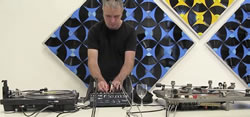

Christian Marclay’s work, which combines visual and sound art practices, utilises the vinyl record (along with other audio media objects) as a material for sculpture and collage. In his visual art practice, Marclay creates large sculptural works, such as towering columns of records stacked on top of each other, a large doughnut of records strung together with a wire through their central holes, and records melted and crushed into cubes. In all these works, the vinyl record is treated not only as a sculptural material but also as a cultural artifact with a specific history. In a similar way, Schulzemix seeks to go beyond a merely æsthetic exploration of form in order to inquire into the cultural-material nature of the vinyl medium. Future projects will aim at building systems that are significantly more automatic and can thus run as installation pieces.
Bibliography
Brecht, George. Chance-Imagery, New York: A Great Bear Pamphlet, 1966. Available online at <http://www.ubu.com/historical/gb/brecht_chance.pdf>. Last accessed 3 May 2008.
Cage, John. Silence: Lectures and Writings, London: Calder & Boyars, London, 1968.
Cage, John and Daniel Charles. For the Birds, Boston: M. Boyars, 1981.
Higgins, Dick. A Dialectic of Centuries: Notes Towards a Theory of the New Arts, New York: Printed Editions, 1978.
Nyman, Michael. Experimental Music: Cage and Beyond. 2nd edition, New York: Cambridge University Press, 1999.
Social top